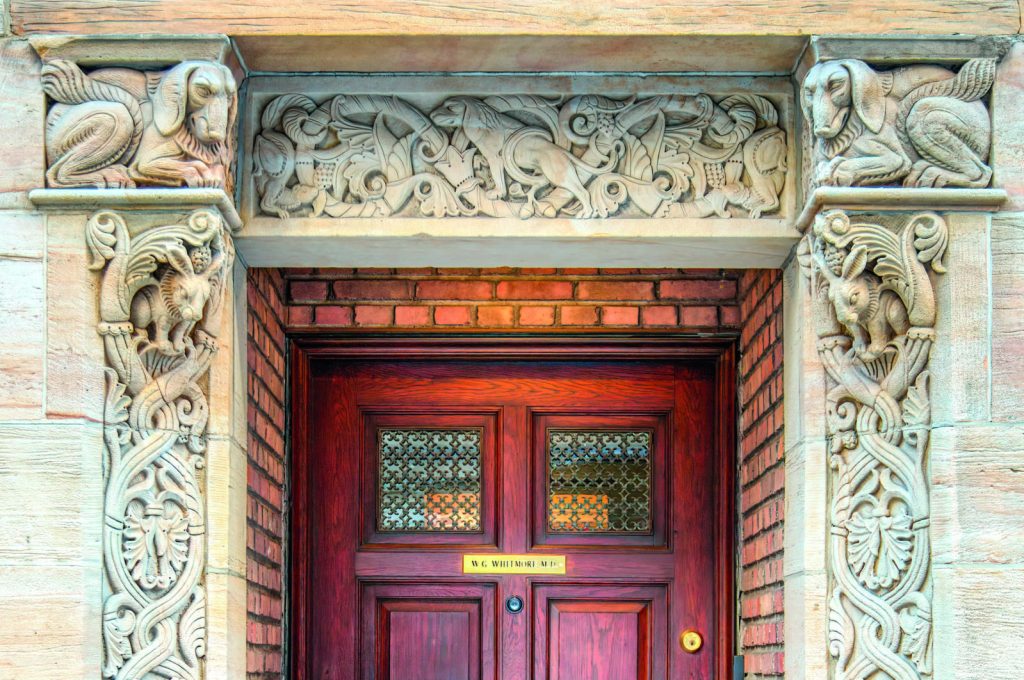The architectural historian Andrew Alpern has for decades done the dirty work when it comes to pre-war New York apartments. Others have presented glossy coffee-table books full of newly commissioned professional photographs. Alpern has focused on the practical details of apartment design, especially floor plans, which tell us so much about how people actually live in their apartments, or at least were originally meant to. His Apartments for the Affluent (1975), Historic Manhattan Apartment Houses (1996) and New York Apartment Houses of Rosario Candela and James Carpenter (2002) are essential compendia; anyone with an interest in New York residential architecture, especially of the magnificent variety, must have them. The more industrious uptown real estate agents also find them useful.
Now Alpern has published Posh Portals: Elegant Entrances and Ingratiating Ingresses to Apartments for the Affluent in New York City (if there were a yearly award for Most Conspicuous Subtitle, this would be a finalist). Alpern is joining the ranks of the coffee-tablers, and who can blame him? Architectural historians are allowed to have fun, too. But rather than interior shots of moldings, fireplaces, bath taps and the like, Alpern’s book focuses on the entrances to New York’s finest buildings, which are often indicative of the building’s status and quality as a whole. Lest one ding Alpern for going in for portals alone, remember that architectural history is, like God, all details. This is why I considered writing my MA dissertation on boot scrapers in London, before diverting to the forgotten bridges of Robert Adam for the sensible reason that no one had done so already.
In his introduction, Alpern poses the essential question when it comes to apartment house doors: ‘Is the entrance merely the way into the building, or does it glorify that act of entering?’ One could hardly produce a book of unremarkable doorways, so the answer here is the latter.
Contained in the book are 140 or so buildings, often frightfully grand. The Dakota on West 72nd St, now known mostly as the set of Rosemary’s Baby and the site of John Lennon’s home and murder, was famous in its heyday for a porte cochère large enough for horse-drawn carriages to fit through (and a courtyard large enough for them to turn around in). Moving down the social scale, and just across from my own apartment, 325 East 79th St sports a desultory Venetian Gothic entrance appliqué on its front, like an uncommitted guest at a costume ball.
Alpern traces how entrances relate to their buildings as a whole, and takes the reader through styles ranging from Beaux-Arts to Art Deco, the latter admitting such stylistic deviance as the ‘neo-Mayan’ zigzags of 3 East 84th St. All this works to display the stunning range of architectural diversity in New York apartments. That might come as a surprise to out-of-towners who think only of the limestone fortresses of Fifth Avenue or the red-brick beauties of Park. Augmenting Kenneth Grant’s photographs — one quibble, they seem to all use an HDR setting, making them appear hyperreal — are twee drawings by Simon Fieldhouse, inserting comical human figures into these doorway scenes. I would have preferred that page space be spent on detail shots of the façades — instead of a closeup of the elegant arched portal at 834 Fifth Avenue, we get a doctor using a stethoscope on a tourist — but it’s their book, not mine.
Had Alpern more room, he might have included the National Arts Club Studios on East 19th St, a 13-story, red-brick building with an imposing double-height stone entryway complete with a pointed arch, much stained glass and carved grotesques. Sometimes the gates of paradise are in fact the gates of hell. Inside the Studios, O. Aldon James, who served as the National Arts Club’s president for 25 years until his resignation and eventual expulsion in 2012 for alleged malfeasance most foul, kept a menagerie of exotic birds, including a raven called Reverend.
Still, if I catalogued the delights in this book, we’d be here all year. A few quick favorites: the ‘neo-medieval’ griffin carvings of 40 East 62nd St; the bulldog guarding a side door at 116 East 68th St; the bust of Thomas Gainsborough triumphant in his baroque frame at the Gainsborough Studios on Central Park South; the sandstone pediment framing a window above the round-arch entrance to 820 Park Avenue; the carved head of Neptune that serves at the keystone to 1 East End Avenue, underscoring its glorious river views; and, points for audacity, the terracotta screens draping like icicles over the windows of the Flemish Gothic 45 East 66th St. They say New Yorkers never look up. With all these treasures at or just above ground level, now we know why.
Andrew Alpern’s Posh Portals: Elegant Entrances and Ingratiating Ingresses to Apartments for the Affluent in New York City is published by Abbeville Press ($75). This article is in The Spectator’s October 2020 US edition.

























